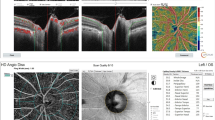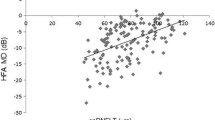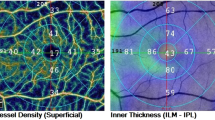Abstract
Purpose
To explore how optic disc perfusion varies in patients with open-angle glaucoma (OAG) and how this correlates with glaucoma severity.
Methods
We performed a prospective and cross-sectional observational study that included 62 eyes from 62 patients with OAG, divided into three groups according to their visual field (VF) results, and 20 eyes from 20 normal control subjects. Optic disc perfusion was studied using optical coherence tomography angiography (angio-OCT), and flow index and vessel density were determined. The VF, mean deviation (MD), pattern standard deviation (PSD), retinal nerve fiber layer (RNFL) thickness, and ganglion cell complex (GCC) thickness were also recorded. The potential associations between disc perfusion and VF defects or structural loss were analyzed.
Results
In OAG patients, the disc flow index and vessel density were significantly lower than in normal controls (all p<0.001) and were correlated with the severity of glaucoma. In OAG eyes, the flow index and vessel density were significantly correlated with MD, RNFL, and GCC thickness (all p<0.01), but were not in the normal controls. The receiver operating characteristic (ROC) curve analysis also revealed that disc flow index and vessel density had the power to differentiate normal eyes from eyes with OAG (under the ROC curves: 0.82 and 0.80, respectively).
Conclusions
Angiograms demonstrated a reduced disc flow index and vessel density in glaucoma, and this reduction was closely related to GCC thickness. This indicated that measurement of disc perfusion by angio-OCT might be important for the monitoring of glaucoma.


Similar content being viewed by others
References
Resnikoff S, Pascolini D, Etya’ale D et al (2004) Global data on visual impairment in the year 2002. Bull World Health Organ 82:844–851
Caprioli J (2007) Intraocular pressure fluctuation: an independent risk factor for glaucoma? Arch Ophthalmol 125:1124–1125
Caprioli J, Coleman AL (2008) Intraocular pressure fluctuation a risk factor for visual field progression at low intraocular pressures in the Advanced Glaucoma Intervention Study. Ophthalmology 115:1123–1129
Pan Y, Varma R (2011) Natural history of glaucoma. Indian J Ophthalmol 59:S19–S23
Heijl A, Leske MC, Bengtsson B, Hyman L, Hussein M (2002) Reduction of intraocular pressure and glaucoma progression: results from the Early Manifest Glaucoma Trial. Arch Ophthalmol 120:1268–1279
Musch DC, Gillespie BW, Lichter PR, Niziol LM, Janz NK (2009) Visual field progression in the Collaborative Initial Glaucoma Treatment Study: the impact of treatment and other baseline factors. Ophthalmology 116:200–207
Collaborative Normal-Tension Glaucoma Study Group (1998) The effectiveness of intraocular pressure reduction in the treatment of normal-tension glaucoma. Am J Ophthalmol 126(4):498–505
Flammer J, Orgul S, Costa VP et al (2002) The impact of ocular blood flow in glaucoma. Prog Retin Eye Res 21:359–393
Schmidl D, Garhofer G, Schmetterer L (2011) The complex interaction between ocular perfusion pressure and ocular blood flow - relevance for glaucoma. Exp Eye Res 93:141–155
Emre M, Orgul S, Gugleta K, Flammer J (2004) Ocular blood flow alteration in glaucoma is related to systemic vascular dysregulation. Brit J Ophthalmol 88:662–666
Leske MC (2007) Open-angle glaucoma: an epidemiologic overview. Ophthalmic Epidemiol 14:166–172
Bonomi L, Marchini G, Marraffa M et al (2000) Vascular risk factors for primary open angle glaucoma: the Egna-Neumarkt Study. Ophthalmology 107:1287–1293
Rojanapongpun P, Drance SM, Morrison BJ (1993) Ophthalmic artery flow velocity in glaucomatous and normal subjects. Br J Ophthalmol 77:25–29
Chung HS, Harris A, Kagemann L, Martin B (1999) Peripapillary retinal blood flow in normal tension glaucoma. Br J Ophthalmol 83:466–469
Yin ZQ, Vaegan, Millar TJ, Beaumont P, Sarks S (1997) Widespread choroidal insufficiency in primary open-angle glaucoma. J Glaucoma 6:23–32
Januleviciene I, Sliesoraityte I, Siesky B, Harris A (2008) Diagnostic compatibility of structural and haemodynamic parameters in open-angle glaucoma patients. Acta Ophthalmol 86:552–557
Puliafito CA, Hee MR, Lin CP et al (1995) Imaging of macular diseases with optical coherence tomography. Ophthalmology 102:217–229
Hee MR, Puliafito CA, Wong C et al (1995) Optical coherence tomography of macular holes. Ophthalmology 102:748–756
Hee MR, Baumal CR, Puliafito CA et al (1996) Optical coherence tomography of age-related macular degeneration and choroidal neovascularization. Ophthalmology 103:1260–1270
Schuman JS, Hee MR, Puliafito CA et al (1995) Quantification of nerve fiber layer thickness in normal and glaucomatous eyes using optical coherence tomography. Arch Ophthalmol 113:586–596
Schuman JS, Hee MR, Arya AV et al (1995) Optical coherence tomography: a new tool for glaucoma diagnosis. Curr Opin Ophthalmol 6:89–95
Jia Y, Morrison JC, Tokayer J et al (2012) Quantitative OCT angiography of optic nerve head blood flow. Biomed Opt Express 3:3127–3137
Jia Y, Tan O, Tokayer J et al (2012) Split-spectrum amplitude-decorrelation angiography with optical coherence tomography. Opt Express 20(4):4710–4725
Wang X, Jia Y, Spain R et al (2014) Optical coherence tomography angiography of optic nerve head and parafovea in multiple sclerosis. Br J Ophthalmol 98:1368–1373
Jia Y, Wei E, Wang X et al (2014) Optical coherence tomography angiography of optic disc perfusion in glaucoma. Ophthalmology 121(7):1322–1332
Wei E, Jia Y, Tan O, Potsaid B, Liu JJ et al (2013) Parafoveal retinal vascular response to pattern visual stimulation assessed with OCT angiography. PLoS One 8(12):e81343
Kaeser P, Orgul S, Zawinka C, Reinhard G, Flammer J (2005) Influence of change in body position on choroidal blood flow in normal subjects. Br J Ophthalmol 89:1302–1305
Longo A, Geiser MH, Riva CE (2004) Posture changes and subfoveal choroidal blood flow. Invest Ophthalmol Vis Sci 45:546–551
Sayegh FN, Weigelin E (1983) Functional ophthalmodynamometry. Comparison between brachial and ophthalmic blood pressure in sitting and supine position. Angiology 34:176–182
Riva CE, Grunwald JE, Petrig BL (1986) Autoregulation of human retinal blood flow. An investigation with laser Doppler velocimetry. Invest Ophth Vis Sci 27:1706–1712
Talusan E, Schwartz B (1977) Specificity of fluorescein angiographic defects of the optic disc in glaucoma. Arch Ophthalmol 95:2166–2175
Schwartz B, Rieser JC, Fishbein SL (1977) Fluorescein angiographic defects of the optic disc in glaucoma. Arch Ophthalmol 95:1961–1974
Piltz-Seymour JR, Grunwald JE, Hariprasad SM, Dupont J (2001) Optic nerve blood flow is diminished in eyes of primary open angle glaucoma suspects. Am J Ophthalmol 132:63–69
Hamard P, Hamard H, Dufaux J, Quesnot S (1994) Optic nerve head blood flow using a laser Doppler velocimeter and haemorheology in primary open angle glaucoma and normal pressure glaucoma. Br J Ophthalmol 78:449–453
Michelson G, Langhans MJ, Groh MJ (1996) Perfusion of the juxtapapillary retina and the neuroretinal rim area in primary open angle glaucoma. J Glaucoma 5:91–98
Yokoyama Y, Aizawa N, Chiba N et al (2011) Significant correlations between optic nerve head microcirculation and visual field defects and nerve fiber layer loss in glaucoma patients with myopic glaucomatous disk. Clin Ophthalmol 5:1721–1727
Karczewicz D, Modrzejewska M (2004) Assessment of blood flow in eye arteries in patients with myopia and glaucoma. Klin Oczna 106(1–2 Suppl):214–216
Melo GB, Libera RD, Barbosa AS, Pereira LM, Doi LM, Melo LJ (2006) Comparison of optic disk and retinal nerve fiber layer thickness in nonglaucomatous and glaucomatous patients with high myopia. Am J Ophthalmol 142:858–860
Funding statement
Project supported by the National Major Scientific Equipment program (Grant No. 2012YQ12008003, China), by the Special Scientific Research Project of Health Professions (Grant No. 201302015, China)
Conflict of interest
Tony Ko is an employee of Optovue, Inc.
Author information
Authors and Affiliations
Corresponding author
Additional information
Xiaolei Wang and Chunhui Jiang contributed equally to this work.
Rights and permissions
About this article
Cite this article
Wang, X., Jiang, C., Ko, T. et al. Correlation between optic disc perfusion and glaucomatous severity in patients with open-angle glaucoma: an optical coherence tomography angiography study. Graefes Arch Clin Exp Ophthalmol 253, 1557–1564 (2015). https://doi.org/10.1007/s00417-015-3095-y
Received:
Revised:
Accepted:
Published:
Issue Date:
DOI: https://doi.org/10.1007/s00417-015-3095-y




